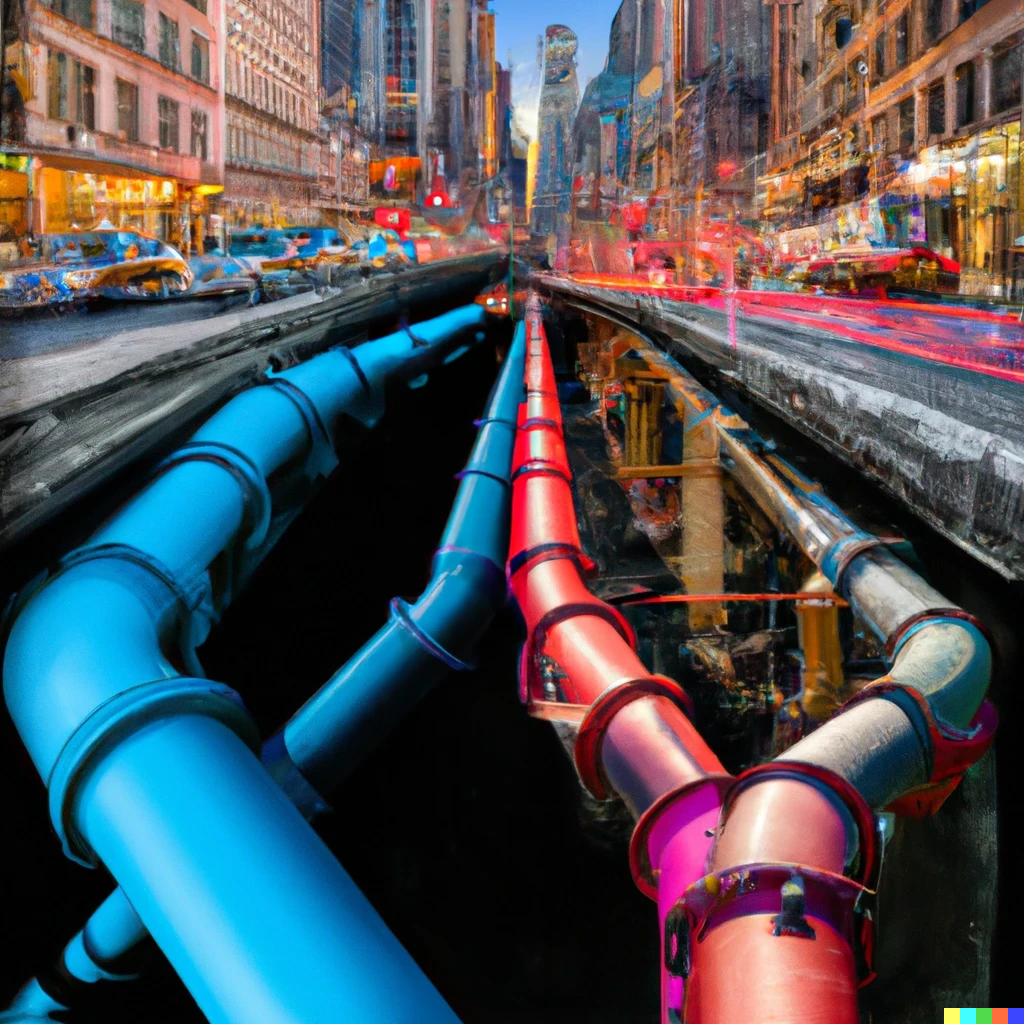I am writing a five-part miniseries about cities to consolidate and record my learning about urban planning and economic development. These thoughts represent a synthesis from books, talks, podcasts, conversations, documentaries, and our work at Subcity. Part IV is Four Counterintuitive Ideas About Cities and this is the final piece in this series.
Dall-E Prompt: new york city above ground and below ground visualization with subway pipes
Kate Ascher’s book, The Works, is a visual and fascinating guide to what is required for a city like New York to function. While she covers dozens of aspects from moving people, moving freight, power, and communications, I’ll focus on a few areas to highlight interesting facts about these essential systems.
Electricity.
On Sept 4, 1882 Thomas Edison “flipped the switch” to begin operations at the Edison Electric Illuminating Company at his new Pearl St generating station. There is still a plaque marking the location in lower Manhattan. Over one hundred years later there is now 80,000 miles of underground electric cable (enough to go around the world 3.5 times) and 250,000 manhole covers across the city.
NYC’s power infrastructure must maintain 5M+ air conditioners, 7M+ TVs, 9M+ cell phones, and millions of computers. Despite these massive numbers, there is benefit in the dense population. The average New Yorker consumes 2,000 kilowatt hours per year, compared to 4,000 for the average American.
New York State’s power grid is among the most complex and congested in the nation, involving more than 330 generating plants. This is all coordinated through an organization called New York Independent System Operator, or ISO. Since electricity cannot be stored, the organization is tasked with constantly matching supply and demand.
1. Each morning it accepts offers from generators that have energy to sell the following day. It takes bids from utilities looking to buy energy for the next day.
2. After sorting the offers by price NYISO selects supply offers until all purchase bids are met; the last supply offer sets the price all buyers pay and all sellers receive.
3. Since supply and demand fluctuate throughout the day, last minute adjustments are made roughly every six seconds.
New York City still leans on an unusual power source, Steam. If you’ve ever seen steam billowing out of an orange and white cylinder vents - that is the steam coming up from its underground pipes. The vents are used to carry the steam above the windshields of passing cars. The United Nations Building, Empire State Building, Rockefeller Center, and the Met are just some steam users for heating, air conditioning, and hot water. Steam represents 7% of ConEd revenue.
Water.
1.3 billion gallons of water flow each day from reservoirs miles away to the 5 boroughs. The collect pond - near Franklin and Pearl St., was the first source of water for the young city. Yellow fever and cholera epidemics in the 1800s caused the city to look further for fresh water.
● First, the Croton river in Westchester was dammed and there was a Yorkville receiving reservoir and then Murray Hill distributing reservoir (now the site of the NYPL at Bryant Park). This required 30 miles of tunnels.
● Next, the Ashokan Reservoir was created. This required a 92-mile aqueduct.
● Finally, the Delaware System of reservoirs was built. This water source is over 125 miles away and needs to travel through a system of tunnels and aqueducts. It now provides over half of the city’s water.
The entire water system for New York City is 18 reservoirs. It involved the flooding of 30 communities and displacement of 9,000 people. On top of that, 11,500 graves had to be dug up and reburied. In order to bring water safely from Upstate NY throughout the city, massive water tunnels need to be built. Water Tunnel No. 3 is the largest capital construction project in New York City history. The tunnel will be more than 60 miles long, travel 500 feet below street level in sections, and will cost over $6 billion. Construction began in 1970 and is expected to be fully completed in 2032. The tunnel will serve as a backup to Water Tunnel No. 1, completed in 1917, and Water Tunnel No. 2, completed in 1936.
Waste.
Each day, New York produces about 12,000 tons of residential and municipal waste. Since 1957 commercial waste from businesses has been left to private haulers. 10,000 employees and almost 6,000 vehicles work to collect and dispose of this waste. Their additional responsibilities include snow clearing during Winter, confetti and trash clean up after parades and New Year celebrations, and other random assignments like disposing of Christmas Trees in January.
Where does the garbage go? Two-thirds of it ends up in landfills in Pennsylvania and the rest in Virginia. There are 66 transfer stations around the 5 boroughs where the garbage is loaded onto larger trucks for long-distance travel to remote landfills. For just one example, each day, a train of 35 cars of containerized garbage pulls out from a warehouse at the Harlem River Yards in the South Bronx destined for Waverly, Virginia...400 miles away.
Metal, glass, and plastic are collected separately from paper and currently delivered to one company - Hugo Neu - which barges the recyclables to its plant in Jersey City.
Underneath the city, there are programs and infrastructure designed to support the buildings, equipment, people, and jobs - the very things that have always made cities engines of upward mobility for humanity. These enormous energy, water, and waste systems operate in the background and ensure that the city not only functions but thrives.
